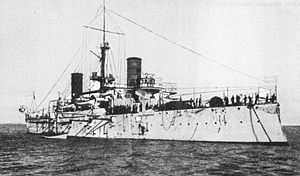ARA General Belgrano (1896)
 | |
| Career (Argentina) | |
|---|---|
| Name: | Belgrano |
| Namesake: | Manuel Belgrano |
| Builder: | Orlando, Livorno |
| Launched: | 25 July 1897 |
| Completed: | 8 October 1898 |
| Acquired: | 1897 |
| Struck: | 8 May 1947 |
| Fate: | Sold for scrap, 1953 |
| General characteristics | |
| Class and type: | Giuseppe Garibaldi-class armoured cruiser |
| Displacement: | 7,069 long tons (7,182 t) |
| Length: | 344 ft 2 in (104.9 m) |
| Beam: | 50 ft 8 in (15.4 m) |
| Draught: | 23 ft 4 in (7.1 m) |
| Installed power: | 13,000 ihp (9,700 kW) |
| Propulsion: | 2 shafts, vertical triple-expansion steam engines 8 cylindrical boilers |
| Speed: | 20 knots (37 km/h; 23 mph) |
| Complement: | 520 |
| Armament: | 2 × 1 - Armstrong 10-inch (254 mm) guns 14 × 1 - 6-inch (152 mm) guns |
| Armour: | Belt: 3.1–5.9 in (79–150 mm) Barbettes: 5.9 in (150 mm) Gun turrets: 5.9 in (150 mm) Conning tower: 5.9 in (150 mm) |
ARA General Belgrano was a Giuseppe Garibaldi-class armoured cruiser of the Argentine Navy. The ship was built in Italy, along with three sisters ships for the Argentine Navy (Garibaldi, Pueyrredón and San Martín). The ship was launched in 1896 and served on the Argentine Navy until she was stricken on 8 May 1947.
Service history
The cruiser was built at the Cantiere Navale Fratelli Orlando, in Livorno, where her hull was laid down in 1896 and launched on July 25, 1897. She was purchased in 1898 by the government of Argentina, engaged in a diplomatic conflict with Chile. After testing of machinery and artillery, General Belgrano entered service on October 8, 1898, departing the same day entered the port of Genoa, under the command of Captain Emilio Barilari, arriving at their destination in Mar del Plata, on November 6 of that year.
After the conflict with Chile, January 20, 1899 she carried the President of Argentina Julio Argentino Roca and the President of Chile Federico Errazuriz Echaurren for signing the peace treaty. After visiting Santa Cruz, Rio Gallegos, Puerto Harberton and Ushuaia, arrived on February 15, 1899 in Punta Arenas where the two presidents signed the peace treaty between the two countries.
In 1902 he was put on hold and after being fitted with a telegraph set in 1907, she was drafted into the fleet again in 1908. In 1912 she was equipped with a radio transmitter. In 1927 he began work to modernize the naval base of Puerto Belgrano, but before the end of this modernization, left for Europe, visiting Genoa, from 7 to October 16, where the crew attended the unveiling of a monument to General Belgrano. Later, she visited Spain and again returned to Genoa to continue the modernization work, including the conversion of boilers to consume gasoline, installing a new mast and changes in the artillery.
At the end of this modernization, October 25, 1929 arriving part to Buenos Aires on November 24 next. In 1933 she ranked as a coast guard ship and in December the same year is sent to Mar de Plata to be used as a depot ship for submarines. On May 8, 1947, after nearly 50 years of service, General Belgrano was discharged. Towed to Buenos Aires, she was broken up in the Matanza River shipyards.
References
- Gardiner, Robert, ed. (1985). Conway's All the World's Fighting Ships, 1906–1921. Annapolis, Maryland: Naval Institute Press. p. 400. ISBN 978-0-87021-907-8. OCLC 12119866.
Further reading
- (Spanish) Burzaco, Ricardo. Acorazados y Cruceros De La Armada Argentina. Eugenio B, Buenos Aires, 1997. ISBN 987-96764-0-8
- (Spanish) Arguindeguy, Pablo. Apuntes sobre los buques de la Armada Argentina (1810–1970). Comando en Jefe de la Armada, Buenos Aires, 1972. ISBN n/a
| ||||||||||||||||||||||||||||||